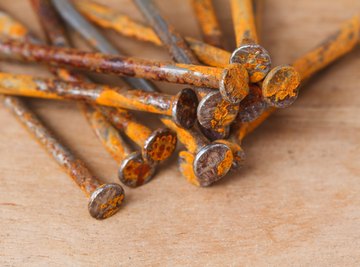
If you ever wonder why nails rust, it's because rusting happens when a metal is exposed to oxygen. The "rust" is actually iron oxide and forms when the iron in the nail reacts with the oxygen in the air or in liquids. The molecules of iron on the surface of the nail exchange atoms with the oxygen in the air and produce a new substance, the reddish-brown ferrous oxide, a.k.a. rust. A simple science project tests the effects of different liquids on the rusting process, such as oil, water, vinegar and detergent.
TL;DR (Too Long; Didn't Read)
The rusting process of a nail speeds up considerably when it is in certain types of liquids. Water removes electrons from iron, leaving it positively charged. Oxygen then reacts to the positively charged iron and creates ferrous oxide. Salt water is an electrolyte, which contains charged atoms. Charged atoms cause iron to lose electrons more readily and allow oxygen to bind with the iron more freely, which accelerates rusting.
Things You'll Need
- Test tubes or plastic cups (numbered)
- Steel nails (not galvanized ones as these resist corrosion)
- Cooking oil
- Tap water
- Vinegar
- Lemon juice
- Salt water
- Detergent
Wear safety goggles and gloves at all times. If you use bleach or stronger acidic substances in your experiment, have adult supervision.
Place numbered test tubes or cups in a line to let you compare the effects of different liquids on your nails. Before you begin your experiment, take a photograph of each nail. You may also weigh each nail at this point. Place one nail in each test tube or cup.
Add a different liquid to each test tube or cup. For example, if you have six containers you could add cooking oil, tap water, vinegar, lemon juice, salt water and detergent. Write down what liquid is in each container. Over several days, take regular notes on each nail's condition. Record which nail showed rust first.
Repeat the above steps, but this time try different conditions. For example, you could compare a nail completely submerged in water to a nail only half submerged in water, or observe a nail completely submerged in water with a layer of oil on the top of it. You could compare a nail in salt water and a nail in pure salt.
At the end of your experiment, remove the nails from their containers. Weigh them to determine whether there is any difference between them.
Warnings
References
About the Author
Claire is a writer and editor with 18 years' experience. She writes about science and health for a range of digital publications, including Reader's Digest, HealthCentral, Vice and Zocdoc.
